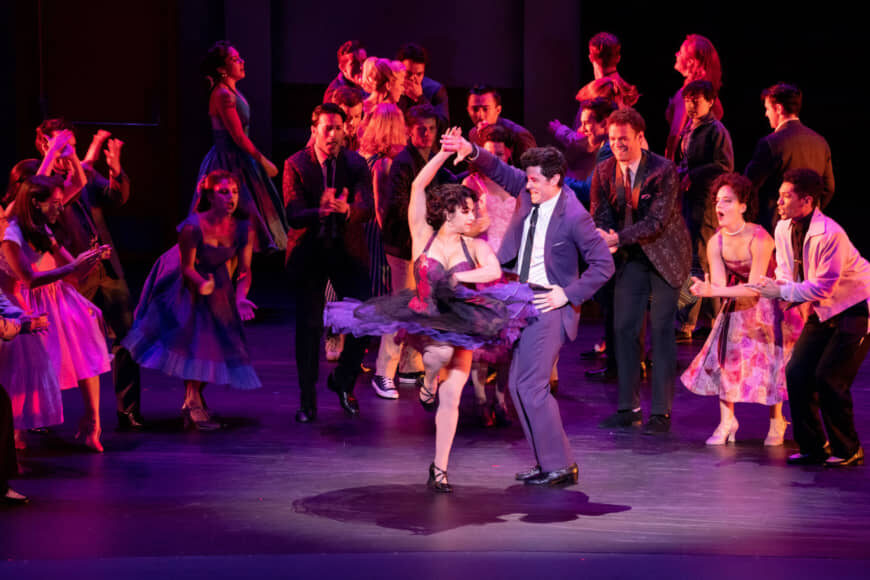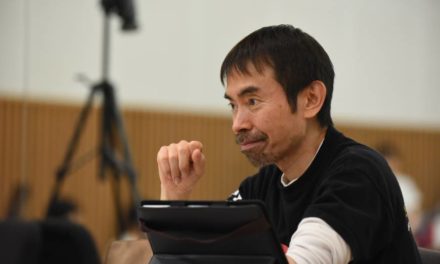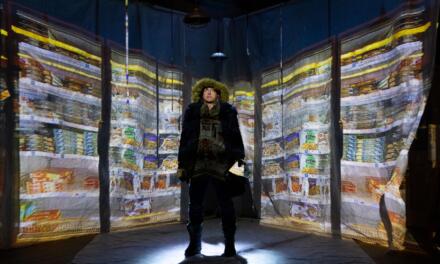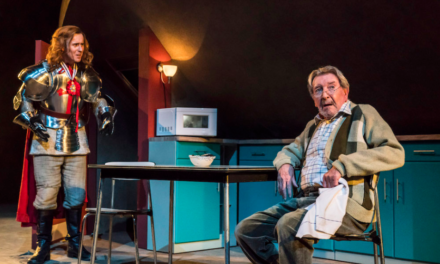Back in 1961, Robert Wise and Jerome Robbins’ Hollywood film West Side Story became something of a worldwide sensation when it won 10 Oscars — still the most ever for a big-screen adaptation of a musical.
Among the fans of that groundbreaking teen-tragedy about love and ethnic tensions in a tough 1950s New York neighborhood, young women the world over idolized one of its stars in particular — George Chakiris, who played Bernardo, the leader of a gang who many likely wished could step out from the screen, kick his long legs in the air, and sing and dance in front of their eyes.
Now, at the IHI Stage Around Tokyo theater in the Toyosu waterfront district of Koto Ward, that dream is coming as close to reality as it’s ever likely to be.
The production of West Side Story running there with an American cast through Oct. 27 (followed by a run with a Japanese cast) is a new version of director and choreographer Robbins’ 1957 Broadway musical of the same name, based on a book by Arthur Laurents and with music by Leonard Bernstein and lyrics by Stephen Sondheim.
That classic show inspired by Shakespeare’s Romeo and Juliet has, however, been especially refashioned for this theater with its 360-degree moveable stages and screens encircling a 1,300-seat rotating auditorium. With that unusual configuration, numerous sets can be created so audiences get to experience an uninterrupted, filmic flow of scenes.
With the Bard’s feuding families replaced here by two teenage gangs locked in a turf war — the white Jets led by Riff (played by Matthew Steriti), and the Puerto Rican immigrants’ Sharks led by Bernardo (George Akram) — the action can be fast and furious. When an actor hops on a motorbike, for example, his riding seems so realistic against the fast-moving scenery behind.
Ultimately, the effect is like a magical mix of high-impact IMAX visuals together with the cast’s high-energy performances — and, of course, the work’s radical blend of jazz, Broadway, and Latin American musical styles.
All this is apparent right from the start, when grainy images of 1950s New York and newspaper articles about racist murders fill a screen spanning a full half-circle which then slides apart from the middle to reveal the gangs’ Lincoln Square hangout in Manhattan as it was before today’s redevelopments on the city’s Upper West Side.
Then, with a finger-snapping rhythm building up, the stage moves around to show the Jets dancing as bright colors take over in a dramatic switch from two- to three-dimensional imagery that seems to bring the 1961 film alive.
Yet, despite the Sharks also claiming Lincoln Park as their domain, when Riff asks his best friend and former gang member Tony (Trevor James Berger) to help the Jets fight them, he refuses.
Tensions mount even higher when Tony and Bernardo’s sister, Maria (Sonya Balsara), fall in love — which leads to one of the most memorable scenes when they secretly meet on her fire escape and sing the haunting duet “Tonight.” Then, as the background changes to a vast night sky, the metal stairs, the lovers, and their voices all rise up and melt away.
But before long the two gangs do finally fight — and tragedy ensues.
Overseeing this epic work playing out in such a challenging theater space is its director, David Saint, a Boston-born, New York resident now in his 23rd season as artistic director of the George Street Playhouse in New Brunswick, New Jersey.
As we talk after a recent performance, he recounts how this project began with a phone call from its producer Kevin McCollum.
“Kevin said there were two theaters in the world with all-around stages, one in Amsterdam and one in Tokyo, and though they’d both done new domestic plays, neither had ever presented a classic musical — and he wanted to do that,” Saint says.
Then, by the time he arrived in Tokyo for rehearsals in mid-July, his planning was already well advanced. In fact, he’d even made a model of the stage that he put on his dining table and kept playing with to work out where the story’s 12 different locations would be.
“I know West Side Story very well as I’ve done it many times,” says the 66-year-old, who directed an acclaimed touring version of 2009’s Tony-nominated Broadway production that came to Japan in 2012. “However, I usually just had one stage and (the cast) needed the room for dancing, but here I have all these spaces and this depth and it’s a big circle. So that set my imagination going.”
Now, after actually working at IHI Stage Around Tokyo, he says, “I love doing this, though you do need a big, larger-than-life story for a unique space like this,” adding, with a laugh, “I’m addicted to it and I feel like I’ve got a big box of toys to play with. In fact, the producers, the Tokyo staff and myself are all talking about what we can do here next.”
Saint says he has been able to team up with a formidable crew.
“I’m also delighted to work with my fantastic designer, Anna Louizos,” he says. “We had hundreds of discussions to create our sets showing places in New York, as well as Maria’s apartment, the fire escape, and a drug store where the actors say they don’t need to act because it’s just like the real thing.”
But getting the production off the ground has not all been plain sailing.
“There were still lots of difficulties with this technically very complicated show, and we spent weeks making all the automated and IT-controlled equipment,” Saint says, “It’s like a puzzle, but the Japanese crew were superb — better than those on Broadway.”
On a final note, the show’s creator conveys his own message regarding this drama about love beset by bigotry.
“When I was planning with my little model, I got the idea to set the final scene at the Bethesda Fountain in Central Park, with its replica of the Angel of Mercy statue,” Saint says, “She is the angel of healing and it’s next to the Upper West Side where this all happens.
“So, realistically, Tony could run there and I thought it was the perfect place for him to die, and Maria could have a big speech with the angel right above her.”
Saint says this gave him the opportunity to reflect on wider social issues.
“After the ending, I decided to run the names of cities such as El Paso (Texas), London, Paris, and Orlando (Florida) on the screen, along with the dates of mass killings there because of people’s race, religion, or sexual identity,” he says, “After all, it’s not changed since this musical was first made in 1957 — and it’s getting worse, actually. It has to stop.”
West Side Story runs with a Broadway cast through Oct. 27 at IHI Stage Around Tokyo in Koto Ward. It then runs there with a Japanese cast from Nov. 6 to Jan. 13. For details, visit www.tbs.co.jp/stagearound.
This article was originally published on https://www.japantimes.co.jp/ on September 17, 2019. Written by Nobuko Tanaka. Reposted with permission. Read the original article.
This post was written by the author in their personal capacity.The opinions expressed in this article are the author’s own and do not reflect the view of The Theatre Times, their staff or collaborators.
This post was written by Nobuko Tanaka.
The views expressed here belong to the author and do not necessarily reflect our views and opinions.


















